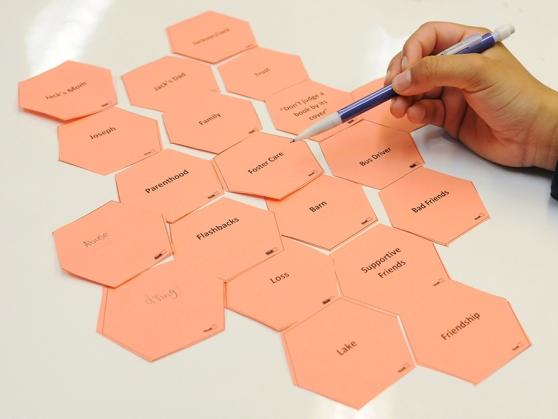
Hexagonal thinking is a discussion technique meant to make connections.
In my middle school English Language Arts classroom, the balance between organic and prompted talk is often hard to strike. How do you teach elaboration, “adding on” and targeted vocabulary without making the discussion feel forced? And wouldn’t it be nice to have a visual cue to reassure you that every student is participating?
Enter hexagonal thinking. Coined by Betsy Potash of the Spark Creativity education site, hexagonal thinking is a discussion technique meant to make connections. Small groups of students start with a few key terms written on a set of paper hexagons. (Teachers can make their own or download a free toolkit at nowsparkcreativity.com.) As a student places one hexagon next to another, they must be able to justify to the group why those two terms are related. If they want to connect a new term to another side of the original hexagon, they must decide if the new term also connects with the second hexagon or if they need to put the third hexagon where it doesn’t touch the second, and so forth.
To start, students need a mix of words with ready connections, such as the setting or characters in a novel, along with high-concept words that could describe themes. For English language learners, adding visuals would be a helpful scaffold. The goal is to use all the hexagons by the end of the group discussion.
I have the groups discuss the arrangement of their hexagons for about 20 minutes and then glue them to a piece of construction paper so that we can look at the diverse ideas as a class when they are finished. For an extension activity, teachers can look outside of their text or historical time period of study to supply contemporary names and concepts to encourage more complex connections.
When each small group presents its arrangement to the class, students have the chance to hear multiple perspectives and discuss connections that they may or may not have made themselves. No two groups, even if they have the same terms, will finish with the same arrangement of hexagons.
This activity can also support student writing: As a post-discussion extension activity, students can choose a few of the connections and write their reasoning. I give each group a small arrow with room for just a few lines of text, but you could ask each group of students to explain their connections by providing specific text evidence or examples.
Optional: gamify it
Everyone in a small group is dealt their own hexagons but can only play a card if everyone agrees on its placement. The next student can play a new card — or “steal” a hexagon that has previously been played and move it to a new position — so long as everyone in the group agrees. This consensus requirement generates a lot of discussion. The first player to get rid of all their cards wins.
Getting students invested in talking with one another is a critical component of successful classroom discussions. Try hexagonal thinking and your room will be buzzing with authentic talk.
Sarah Kuhner, a special education teacher at PS 859, the Special Music School in Manhattan, is National Board certified in ELA.